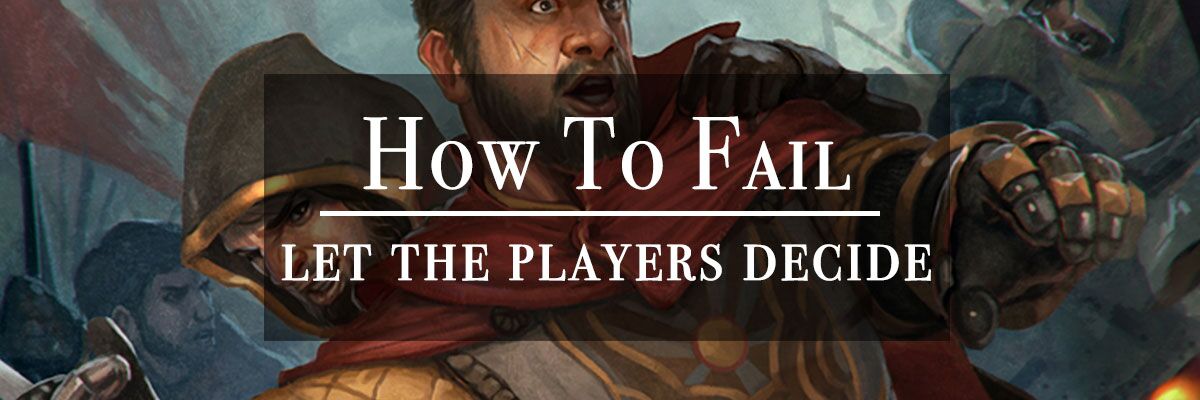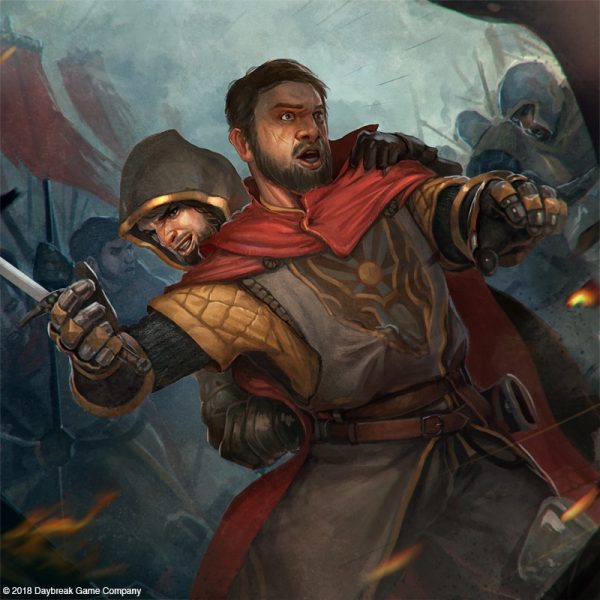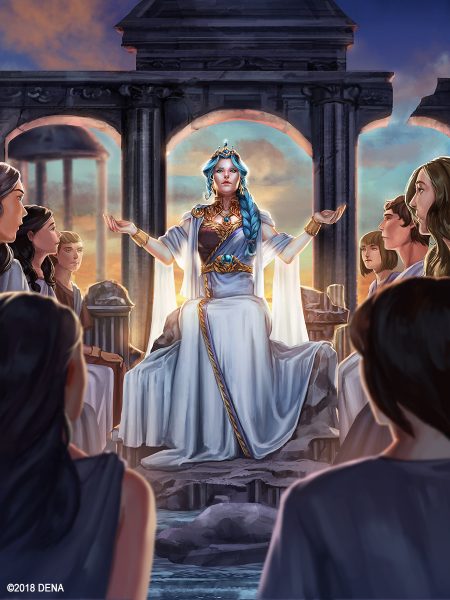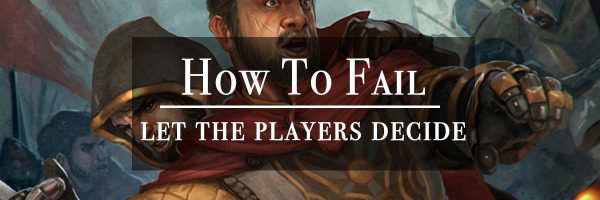Let the Players Decide How They Fail

Game Master (GM): Elembreth, as you carefully examine your surroundings you notice that there is something unusual with one of the tiles on the floor in front of you. The mortar that should join it to the surrounding tiles is missing, leave a thin gap that is a subtle sign this tile is likely the pressure plate that activates a nearby trap.
Finley (playing Elembreth): I’m going to gently lift the pressure plate and attempt to disarm the trap using my thieve’ tools.
GM: Okay. Make a Dexterity ability check and add your proficiency bonus since you are using your tools.
Finley (rolling a D20): Oh no, a one.
This situation is likely all too familiar. As the Game Master, you have to decide the consequences for failure. Depending on the game and edition you’re playing, there may or may not be a rule that makes a rolling a 1 on a d20 a special result. Regardless, most GMs are usually inclined to ratchet up the severity of the consequences based on how badly the roll missed the mark.
Most of the time, this creates spectacular moments involving hilarious mishaps or tear-jerking loss. They are moments about which the players will tell stories for years to come. The approach is not without difficulties so it’s worth considering if there is a better way. Spoiler – there absolutely is and it can profoundly change your game!
Running a Game is Hard

Narrating failure can create a lot of fun and drama at the table, but it requires that Game Masters be prepared to consider how the story can move forward in the face of failure. Many GMs that do this already use random tables or expensive play aids, like critical fumble decks, to help them make the most of these failures.
If you want to make running a game much easier, give this responsibility to the players. Specifically, have the player whose character just failed an Ability Check tell you what happens. When the barbarian rolls a natural 1 on their attack, give them the opportunity to describe what that failure looks like. It might seem unusual to do this if most of you’re mostly only familiar with roleplaying games that place the GM in a position of authority, but there are many more games that share the onus of creating the fiction of the game with everyone that is playing. For a few good reasons, too.
Keeping Your Players Engaged
Clearly, there are times when failure can be fun. When there is a lot riding on the results of a roll, tension rises quickly with each failure. What isn’t fun is when repeated failures leave a player feeling like they have accomplished less than nothing. Giving them back some of their lost autonomy by letting them describe the nature of their failure provides an opportunity to play their character despite a string of bad rolls.
This might sound like you’re encouraging players to erase their failures. Some of them might be tempted to do so. As the Game Master, you can establish boundaries on this technique. When you’re talking with your players during your Session 0 for the campaign, let them know how you will be handing them authorial control of the failures that befall their characters. Set your boundaries then, not later. Do you want everything to make sense within the fiction? Should you still decide when failure results in damage, but leave the rest to the player? Do you want to have veto authority over the narrative they propose? Communicate these issues clearly so that you and your players have the same expectation and then marvel as they start generating ideas that you can use to up your game.
Improvement Through Collaboration

Players shape their campaign in many ways. Their characters are often the primary tool for them to express their desires, using them to explore that empty tomb, talk to that mysterious shop keeper, or stalking the shadows looking for an unwary victim to rob. Maybe things come up in a conversation or email after the game. However it happens, many Game Masters take inspiration from these events. They turn that inconsequential statue the bard keeps asking about into a switch that swings open a door to a secret passage. They abandon the NPC intended to be the plot’s mastermind in favor of the one suspected by the elaborate conspiracy theory that the warlock just told his party about.
When players get to decide their own fate when faced with failure, it can generate similar moments. Sometimes they might impart too much significance on an element of scenery or your description of events points them in a different direction. It’s tempting to correct them and pull them back on track, but you don’t have to. You can resolve the incongruity and build a new, possibly better, story out of it. And if GM was never prepared at all for their failure? All the better. They no longer need to worry if the failure is going to be relevant or move the story forward in interesting ways. They can build these features collaboratively with their players right at the moment as the action unfolds. This does, of course, assume that the players know what is good for them.
Failing Gracefully
It is entirely possible that given the opportunity to create their own outcomes for failure, players will inflict much more punitive terms upon their characters. This really only becomes a problem if the resulting narrative prevents gameplay from continuing to move forward. Otherwise, the players are simply helping the Game Master create difficult situations that they will need to find a way to deal with. After realizing that they have made failure too hard for themselves, most players should begin to self-correct. The GM can also gently nudge players toward less onerous outcomes.
The success of the technique rests with how open and communicative everyone is able to be at the table. Just as you set boundaries for how the procedure will be invoked, the Game Master should set boundaries for how intense failure should be. So go ahead and let the players decide what happens when they fail!

David Adams
Part-time freelancer, full-time wizard. Works for coin or spell scrolls.
David Adams has been pestering Dungeons and Dragons publishers for the past 12 years and managed to collect a myriad of credits in that time. He has had the good fortune of seeing his content published by the likes of Kobold Press and Wizards of the Coast in addition to other recognizable companies. David started playing D&D when he was 16 and the game has been an amazing outlet for creativity as well as a fascinating space to explore complex social issues while simultaneously slaying dragons in epic combat. The ability of the game, regardless of edition, to transmute his interests into exciting experiences he can share with friends is the key aspect that keeps his interests fixed upon it.
Let the Players Decide How They Fail


Game Master (GM): Elembreth, as you carefully examine your surroundings you notice that there is something unusual with one of the tiles on the floor in front of you. The mortar that should join it to the surrounding tiles is missing, leave a thin gap that is a subtle sign this tile is likely the pressure plate that activates a nearby trap.
Finley (playing Elembreth): I’m going to gently lift the pressure plate and attempt to disarm the trap using my thieve’ tools.
GM: Okay. Make a Dexterity ability check and add your proficiency bonus since you are using your tools.
Finley (rolling a D20): Oh no, a one.
This situation is likely all too familiar. As the Game Master, you have to decide the consequences for failure. Depending on the game and edition you’re playing, there may or may not be a rule that makes a rolling a 1 on a d20 a special result. Regardless, most GMs are usually inclined to ratchet up the severity of the consequences based on how badly the roll missed the mark.
Most of the time, this creates spectacular moments involving hilarious mishaps or tear-jerking loss. They are moments about which the players will tell stories for years to come. The approach is not without difficulties so it’s worth considering if there is a better way. Spoiler – there absolutely is and it can profoundly change your game!
Running a Game is Hard

Narrating failure can create a lot of fun and drama at the table, but it requires that Game Masters be prepared to consider how the story can move forward in the face of failure. Many GMs that do this already use random tables or expensive play aids, like critical fumble decks, to help them make the most of these failures.
If you want to make running a game much easier, give this responsibility to the players. Specifically, have the player whose character just failed an Ability Check tell you what happens. When the barbarian rolls a natural 1 on their attack, give them the opportunity to describe what that failure looks like. It might seem unusual to do this if most of you’re mostly only familiar with roleplaying games that place the GM in a position of authority, but there are many more games that share the onus of creating the fiction of the game with everyone that is playing. For a few good reasons, too.
Keeping Your Players Engaged
Clearly, there are times when failure can be fun. When there is a lot riding on the results of a roll, tension rises quickly with each failure. What isn’t fun is when repeated failures leave a player feeling like they have accomplished less than nothing. Giving them back some of their lost autonomy by letting them describe the nature of their failure provides an opportunity to play their character despite a string of bad rolls.
This might sound like you’re encouraging players to erase their failures. Some of them might be tempted to do so. As the Game Master, you can establish boundaries on this technique. When you’re talking with your players during your Session 0 for the campaign, let them know how you will be handing them authorial control of the failures that befall their characters. Set your boundaries then, not later. Do you want everything to make sense within the fiction? Should you still decide when failure results in damage, but leave the rest to the player? Do you want to have veto authority over the narrative they propose? Communicate these issues clearly so that you and your players have the same expectation and then marvel as they start generating ideas that you can use to up your game.
Improvement Through Collaboration

Players shape their campaign in many ways. Their characters are often the primary tool for them to express their desires, using them to explore that empty tomb, talk to that mysterious shop keeper, or stalking the shadows looking for an unwary victim to rob. Maybe things come up in a conversation or email after the game. However it happens, many Game Masters take inspiration from these events. They turn that inconsequential statue the bard keeps asking about into a switch that swings open a door to a secret passage. They abandon the NPC intended to be the plot’s mastermind in favor of the one suspected by the elaborate conspiracy theory that the warlock just told his party about.
When players get to decide their own fate when faced with failure, it can generate similar moments. Sometimes they might impart too much significance on an element of scenery or your description of events points them in a different direction. It’s tempting to correct them and pull them back on track, but you don’t have to. You can resolve the incongruity and build a new, possibly better, story out of it. And if GM was never prepared at all for their failure? All the better. They no longer need to worry if the failure is going to be relevant or move the story forward in interesting ways. They can build these features collaboratively with their players right at the moment as the action unfolds. This does, of course, assume that the players know what is good for them.
Failing Gracefully
It is entirely possible that given the opportunity to create their own outcomes for failure, players will inflict much more punitive terms upon their characters. This really only becomes a problem if the resulting narrative prevents gameplay from continuing to move forward. Otherwise, the players are simply helping the Game Master create difficult situations that they will need to find a way to deal with. After realizing that they have made failure too hard for themselves, most players should begin to self-correct. The GM can also gently nudge players toward less onerous outcomes.
The success of the technique rests with how open and communicative everyone is able to be at the table. Just as you set boundaries for how the procedure will be invoked, the Game Master should set boundaries for how intense failure should be. So go ahead and let the players decide what happens when they fail!

David Adams
Part-time freelancer, full-time wizard. Works for coin or spell scrolls.
David Adams has been pestering Dungeons and Dragons publishers for the past 12 years and managed to collect a myriad of credits in that time. He has had the good fortune of seeing his content published by the likes of Kobold Press and Wizards of the Coast in addition to other recognizable companies. David started playing D&D when he was 16 and the game has been an amazing outlet for creativity as well as a fascinating space to explore complex social issues while simultaneously slaying dragons in epic combat. The ability of the game, regardless of edition, to transmute his interests into exciting experiences he can share with friends is the key aspect that keeps his interests fixed upon it.

0 Comments